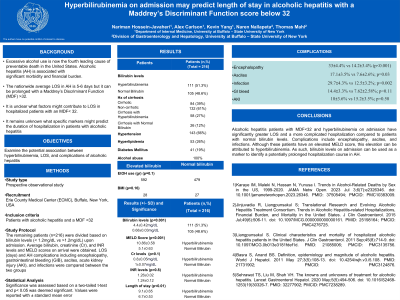Sunday Poster Session
Category: Liver
P0955 - Hyperbilirubinemia on Admission May Predict Length of Stay in Alcoholic Hepatitis With a Maddrey’s Discriminant Function Score Below 32
Sunday, October 22, 2023
3:30 PM - 7:00 PM PT
Location: Exhibit Hall

Has Audio

Nariman Hossein-Javaheri, DO
University at Buffalo
Buffalo, NY
Presenting Author(s)
Nariman Hossein-Javaheri, DO, Alexander M. Carlson, DO, Kevin Yang, MD, Naren S. Nallapeta, MBBS, Thomas C. Mahl, MD
University at Buffalo, Buffalo, NY
Introduction: Excessive alcohol use is now the fourth leading cause of preventable death in the United States. Alcoholic hepatitis (AH) is associated with significant morbidity and financial burden. The nationwide average LOS in AH is 5-6 days but it can be prolonged with a Maddrey’s Discriminant Function (MDF) >32. However, it is unclear what factors might contribute to LOS in hospitalized patients with an MDF< 32. In this study, we aim to examine the potential association between hyperbilirubinemia, LOS, and complications of AH in patients who are not a candidate for steroid therapy.
Methods: 250 patients with AH were identified. Those with an MDF >32 were excluded. The remaining patients (n=216) were divided based on bilirubin levels (< 1.2mg/dL vs >1.2mg/dL) upon admission. Average bilirubin, creatinine (Cr), INR levels, and MELD scores on arrival were obtained. LOS (days) and AH complications including encephalopathy, gastrointestinal bleeding (GIB), ascites, acute kidney injury (AKI), and infections were compared between the two groups. Significance was assessed based on a two-tailed t-test and p< 0.05 was deemed significant. Values were reported with ± standard mean error.
Results: In total, 111 patients had an elevated bilirubin of 4.4±0.42mg/dL vs 105 with a normal bilirubin of 0.68±0.03mg/dL on admission; p< 0.001. With hyperbilirubinemia, the MELD score was also elevated (10.86±0.58 vs 5.1±0.63 p< 0.001). However, Cr (0.8±0.05mg/dL vs 1±0.07mg/dL, p=0.1) and INR (1.26±0.02 vs 1.24±0.12, p=0.8) levels were not significantly different between the two groups. Those with greater bilirubin had a longer LOS (9.1±0.65 vs 6.7±0.53 days; p< 0.01) and a more complicated AH. Incidence of encephalopathy (33±4.4% vs 14.2±3.4%; p< 0.001), ascites (17.1±3.5% vs 7.6±2.6%; p=0.03), and infection (29.7±4.3% vs 12.5±3.2%; p=0.002) was greater among those with an elevated bilirubin. Yet, no significant difference in GIB (14.4±3.3% vs 7.62±2.58%; p=0.11) or AKI (18±3.6% vs 15.2±3.5%; p=0.58) was identified.
Discussion: AH patients with MDF< 32 and hyperbilirubinemia on admission have significantly greater LOS and a more complicated hospitalization compared to patients with normal bilirubin levels. Complications include encephalopathy, ascites, and infections. Although these patients have an elevated MELD score, this elevation can be attributed to hyperbilirubinemia. As such, bilirubin levels on admission can be used as a marker to identify a potentially prolonged hospitalization course in AH.
Disclosures:
Nariman Hossein-Javaheri, DO, Alexander M. Carlson, DO, Kevin Yang, MD, Naren S. Nallapeta, MBBS, Thomas C. Mahl, MD. P0955 - Hyperbilirubinemia on Admission May Predict Length of Stay in Alcoholic Hepatitis With a Maddrey’s Discriminant Function Score Below 32, ACG 2023 Annual Scientific Meeting Abstracts. Vancouver, BC, Canada: American College of Gastroenterology.
University at Buffalo, Buffalo, NY
Introduction: Excessive alcohol use is now the fourth leading cause of preventable death in the United States. Alcoholic hepatitis (AH) is associated with significant morbidity and financial burden. The nationwide average LOS in AH is 5-6 days but it can be prolonged with a Maddrey’s Discriminant Function (MDF) >32. However, it is unclear what factors might contribute to LOS in hospitalized patients with an MDF< 32. In this study, we aim to examine the potential association between hyperbilirubinemia, LOS, and complications of AH in patients who are not a candidate for steroid therapy.
Methods: 250 patients with AH were identified. Those with an MDF >32 were excluded. The remaining patients (n=216) were divided based on bilirubin levels (< 1.2mg/dL vs >1.2mg/dL) upon admission. Average bilirubin, creatinine (Cr), INR levels, and MELD scores on arrival were obtained. LOS (days) and AH complications including encephalopathy, gastrointestinal bleeding (GIB), ascites, acute kidney injury (AKI), and infections were compared between the two groups. Significance was assessed based on a two-tailed t-test and p< 0.05 was deemed significant. Values were reported with ± standard mean error.
Results: In total, 111 patients had an elevated bilirubin of 4.4±0.42mg/dL vs 105 with a normal bilirubin of 0.68±0.03mg/dL on admission; p< 0.001. With hyperbilirubinemia, the MELD score was also elevated (10.86±0.58 vs 5.1±0.63 p< 0.001). However, Cr (0.8±0.05mg/dL vs 1±0.07mg/dL, p=0.1) and INR (1.26±0.02 vs 1.24±0.12, p=0.8) levels were not significantly different between the two groups. Those with greater bilirubin had a longer LOS (9.1±0.65 vs 6.7±0.53 days; p< 0.01) and a more complicated AH. Incidence of encephalopathy (33±4.4% vs 14.2±3.4%; p< 0.001), ascites (17.1±3.5% vs 7.6±2.6%; p=0.03), and infection (29.7±4.3% vs 12.5±3.2%; p=0.002) was greater among those with an elevated bilirubin. Yet, no significant difference in GIB (14.4±3.3% vs 7.62±2.58%; p=0.11) or AKI (18±3.6% vs 15.2±3.5%; p=0.58) was identified.
Discussion: AH patients with MDF< 32 and hyperbilirubinemia on admission have significantly greater LOS and a more complicated hospitalization compared to patients with normal bilirubin levels. Complications include encephalopathy, ascites, and infections. Although these patients have an elevated MELD score, this elevation can be attributed to hyperbilirubinemia. As such, bilirubin levels on admission can be used as a marker to identify a potentially prolonged hospitalization course in AH.
Disclosures:
Nariman Hossein-Javaheri indicated no relevant financial relationships.
Alexander Carlson indicated no relevant financial relationships.
Kevin Yang indicated no relevant financial relationships.
Naren Nallapeta indicated no relevant financial relationships.
Thomas Mahl indicated no relevant financial relationships.
Nariman Hossein-Javaheri, DO, Alexander M. Carlson, DO, Kevin Yang, MD, Naren S. Nallapeta, MBBS, Thomas C. Mahl, MD. P0955 - Hyperbilirubinemia on Admission May Predict Length of Stay in Alcoholic Hepatitis With a Maddrey’s Discriminant Function Score Below 32, ACG 2023 Annual Scientific Meeting Abstracts. Vancouver, BC, Canada: American College of Gastroenterology.
